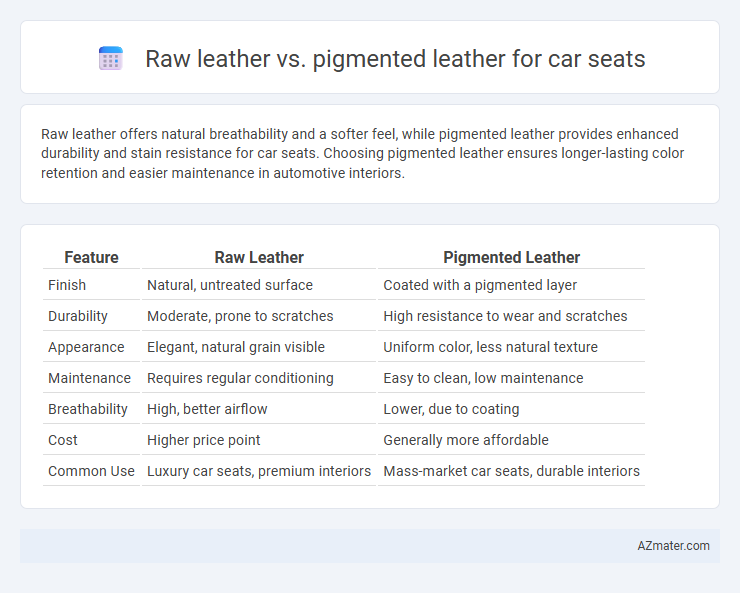Raw leather offers natural breathability and a softer feel, while pigmented leather provides enhanced durability and stain resistance for car seats. Choosing pigmented leather ensures longer-lasting color retention and easier maintenance in automotive interiors.
Table of Comparison
| Feature | Raw Leather | Pigmented Leather |
|---|---|---|
| Finish | Natural, untreated surface | Coated with a pigmented layer |
| Durability | Moderate, prone to scratches | High resistance to wear and scratches |
| Appearance | Elegant, natural grain visible | Uniform color, less natural texture |
| Maintenance | Requires regular conditioning | Easy to clean, low maintenance |
| Breathability | High, better airflow | Lower, due to coating |
| Cost | Higher price point | Generally more affordable |
| Common Use | Luxury car seats, premium interiors | Mass-market car seats, durable interiors |
Introduction to Raw vs Pigmented Leather
Raw leather, also known as aniline leather, offers a natural, soft texture that ages gracefully, showcasing the hide's unique characteristics and imperfections. Pigmented leather, coated with a durable pigment layer, provides enhanced resistance to stains, fading, and wear, making it ideal for high-traffic car seats. Choosing between raw and pigmented leather influences the car interior's aesthetics, maintenance requirements, and durability, with raw leather emphasizing authenticity and pigmented leather prioritizing protection.
Defining Raw Leather for Car Seats
Raw leather for car seats, also known as aniline leather, is minimally treated and retains its natural surface, showcasing the hide's unique textures and imperfections. This type of leather offers superior breathability and a softer, more luxurious feel compared to pigmented leather, which is coated with a protective pigment layer that masks natural characteristics. Raw leather requires careful maintenance to preserve its appearance and durability in automotive applications.
What Is Pigmented Leather?
Pigmented leather for car seats is leather coated with a polymer layer that contains pigments, providing a uniform color and enhanced durability. This coating protects the leather from wear, stains, and UV damage, making it ideal for high-traffic automotive interiors. Unlike raw leather, pigmented leather requires less maintenance while maintaining a consistent appearance over time.
Appearance and Texture Comparison
Raw leather exhibits a natural, rich texture with visible grain and unique markings that enhance its luxurious appearance over time, making it highly desirable for premium car seats. Pigmented leather features a consistent, uniform color and a smoother surface due to the application of a protective coating, resulting in a more durable and easy-to-clean finish. The choice between raw and pigmented leather hinges on the desired aesthetic and tactile experience, with raw leather offering authenticity and warmth, while pigmented leather prioritizes resilience and maintenance simplicity.
Durability and Longevity
Raw leather offers a natural texture and breathability but is more susceptible to wear, stains, and UV damage, requiring regular maintenance to maintain durability. Pigmented leather features a protective coating that enhances resistance to scratches, fading, and spills, significantly extending its longevity in car seats. For long-term durability, pigmented leather typically outperforms raw leather by providing superior surface protection against daily use and environmental factors.
Comfort and Feel
Raw leather offers a softer, more natural feel with increased breathability, enhancing comfort during long drives by allowing better air circulation. Pigmented leather features a durable surface coating that resists stains and wear but can feel stiffer and less breathable, potentially causing discomfort in hot weather. Choosing raw leather prioritizes supple texture and temperature regulation, while pigmented leather emphasizes durability and easier maintenance.
Maintenance and Cleaning Requirements
Raw leather car seats, often called aniline leather, require careful maintenance with specialized leather cleaners and conditioners to preserve their natural texture and prevent stains from setting. Pigmented leather, coated with a protective layer of polyurethane or acrylic pigments, offers easier cleaning and greater resistance to spills, making it more suitable for high-traffic vehicles due to its durability and reduced maintenance needs. Regular vacuuming and wiping with a damp cloth are sufficient for pigmented leather, whereas raw leather demands more frequent attention to avoid dryness and cracking.
Cost Differences
Raw leather tends to be more expensive than pigmented leather due to its natural finish, higher-quality hide, and the extensive tanning process required to preserve its texture and durability. Pigmented leather, coated with a synthetic layer, typically costs less as it utilizes lower-grade hides and simpler manufacturing methods that mask imperfections. Choosing between the two impacts overall vehicle cost significantly, with raw leather elevating luxury appeal and resale value, while pigmented leather offers a budget-friendly, low-maintenance alternative.
Suitability for Different Climates
Raw leather offers superior breathability and moisture absorption, making it ideal for hot and humid climates by reducing sweat buildup and enhancing comfort. Pigmented leather, coated with a durable protective layer, resists UV damage and stains more effectively, which suits cold and varied weather conditions by maintaining appearance and durability. Choosing between raw and pigmented leather depends on the climate demands and desired maintenance level to ensure optimal car seat performance.
Choosing the Right Leather for Your Car
Raw leather offers a natural, breathable surface with a rich texture that develops a unique patina over time, enhancing the interior's luxury appeal. Pigmented leather, coated with a protective finish, provides superior durability, resistance to stains, and ease of cleaning, ideal for families or high-traffic vehicles. When choosing leather for car seats, prioritize raw leather for premium aesthetics and comfort or pigmented leather for long-lasting protection and low maintenance.

Infographic: Raw leather vs Pigmented leather for Car seat
 azmater.com
azmater.com